Related Research Articles
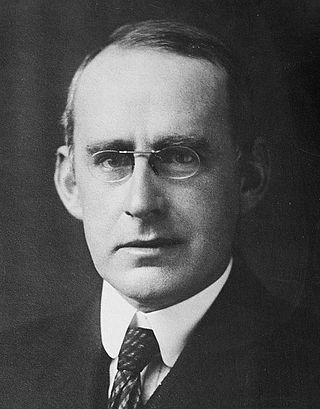
Sir Arthur Stanley Eddington was an English astronomer, physicist, and mathematician. He was also a philosopher of science and a populariser of science. The Eddington limit, the natural limit to the luminosity of stars, or the radiation generated by accretion onto a compact object, is named in his honour.
The Chandrasekhar limit is the maximum mass of a stable white dwarf star. The currently accepted value of the Chandrasekhar limit is about 1.4 M☉ (2.765×1030 kg).
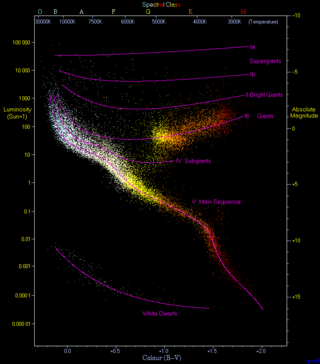
In astronomy, the main sequence is a continuous and distinctive band of stars that appears on plots of stellar color versus brightness. These color-magnitude plots are known as Hertzsprung–Russell diagrams after their co-developers, Ejnar Hertzsprung and Henry Norris Russell. Stars on this band are known as main-sequence stars or dwarf stars. These are the most numerous true stars in the universe and include the Sun.
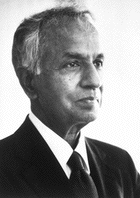
Subrahmanyan Chandrasekhar was an Indian-American theoretical physicist who spent his professional life in the United States. He shared the 1983 Nobel Prize for Physics with William A. Fowler for "...theoretical studies of the physical processes of importance to the structure and evolution of the stars". His mathematical treatment of stellar evolution yielded many of the current theoretical models of the later evolutionary stages of massive stars and black holes. Many concepts, institutions, and inventions, including the Chandrasekhar limit and the Chandra X-Ray Observatory, are named after him.
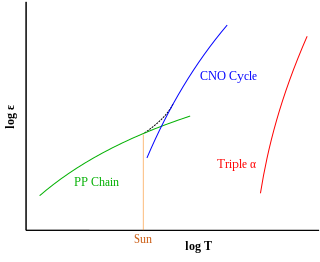
Stellar nucleosynthesis is the creation (nucleosynthesis) of chemical elements by nuclear fusion reactions within stars. Stellar nucleosynthesis has occurred since the original creation of hydrogen, helium and lithium during the Big Bang. As a predictive theory, it yields accurate estimates of the observed abundances of the elements. It explains why the observed abundances of elements change over time and why some elements and their isotopes are much more abundant than others. The theory was initially proposed by Fred Hoyle in 1946, who later refined it in 1954. Further advances were made, especially to nucleosynthesis by neutron capture of the elements heavier than iron, by Margaret and Geoffrey Burbidge, William Alfred Fowler and Fred Hoyle in their famous 1957 B2FH paper, which became one of the most heavily cited papers in astrophysics history.

Astrophysics is a science that employs the methods and principles of physics and chemistry in the study of astronomical objects and phenomena. As one of the founders of the discipline, James Keeler, said, Astrophysics "seeks to ascertain the nature of the heavenly bodies, rather than their positions or motions in space–what they are, rather than where they are." Among the subjects studied are the Sun, other stars, galaxies, extrasolar planets, the interstellar medium and the cosmic microwave background. Emissions from these objects are examined across all parts of the electromagnetic spectrum, and the properties examined include luminosity, density, temperature, and chemical composition. Because astrophysics is a very broad subject, astrophysicists apply concepts and methods from many disciplines of physics, including classical mechanics, electromagnetism, statistical mechanics, thermodynamics, quantum mechanics, relativity, nuclear and particle physics, and atomic and molecular physics.
In physics, a dimensionless physical constant is a physical constant that is dimensionless, i.e. a pure number having no units attached and having a numerical value that is independent of whatever system of units may be used. In aerodynamics for example, if one considers one particular airfoil, the Reynolds number value of the laminar–turbulent transition is one relevant dimensionless physical constant of the problem. However, it is strictly related to the particular problem: for example, it is related to the airfoil being considered and also to the type of fluid in which it moves.
The Eddington Medal is awarded by the Royal Astronomical Society for investigations of outstanding merit in theoretical astrophysics. It is named after Sir Arthur Eddington. First awarded in 1953, the frequency of the prize has varied over the years, at times being every one, two or three years. Since 2013 it has been awarded annually.
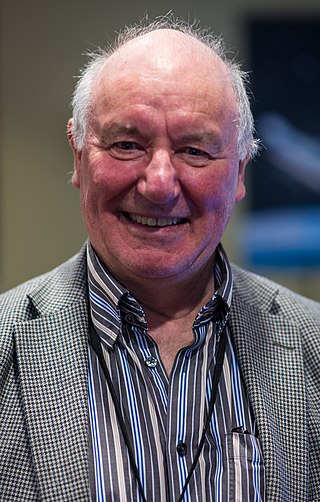
Malcolm Sim Longair is a British physicist. From 1991 to 2008 he was the Jacksonian Professor of Natural Philosophy in the Cavendish Laboratory at the University of Cambridge. Since 2016 he has been Editor-in-Chief of the Biographical Memoirs of Fellows of the Royal Society.

Leon Mestel was an Australian astronomer and astrophysicist and Emeritus Professor at the University of Sussex. His research interests were in the areas of star formation and structure, especially stellar magnetism and astrophysical magnetohydrodynamics. He was awarded both the Eddington Medal (1993) and the Gold Medal of the Royal Astronomical Society. Following his retirement, he wrote several obituaries and biographical articles on physicists and astrophysicists.
In physical cosmology, the Alpher–Bethe–Gamow paper, or αβγ paper, was created by Ralph Alpher, then a physics PhD student, his advisor George Gamow and Hans Bethe. The work, which would become the subject of Alpher's PhD dissertation, argued that the Big Bang would create hydrogen, helium and heavier elements in the correct proportions to explain their abundance in the early universe. While the original theory neglected a number of processes important to the formation of heavy elements, subsequent developments showed that Big Bang nucleosynthesis is consistent with the observed constraints on all primordial elements.

Nuclear astrophysics is an interdisciplinary part of both nuclear physics and astrophysics, involving close collaboration among researchers in various subfields of each of these fields. This includes, notably, nuclear reactions and their rates as they occur in cosmic environments, and modeling of astrophysical objects where these nuclear reactions may occur, but also considerations of cosmic evolution of isotopic and elemental composition (often called chemical evolution). Constraints from observations involve multiple messengers, all across the electromagnetic spectrum (nuclear gamma-rays, X-rays, optical, and radio/sub-mm astronomy), as well as isotopic measurements of solar-system materials such as meteorites and their stardust inclusions, cosmic rays, material deposits on Earth and Moon). Nuclear physics experiments address stability (i.e., lifetimes and masses) for atomic nuclei well beyond the regime of stable nuclides into the realm of radioactive/unstable nuclei, almost to the limits of bound nuclei (the drip lines), and under high density (up to neutron star matter) and high temperature (plasma temperatures up to 109 K). Theories and simulations are essential parts herein, as cosmic nuclear reaction environments cannot be realized, but at best partially approximated by experiments. In general terms, nuclear astrophysics aims to understand the origin of the chemical elements and isotopes, and the role of nuclear energy generation, in cosmic sources such as stars, supernovae, novae, and violent binary-star interactions.
A stellar core is the extremely hot, dense region at the center of a star. For an ordinary main sequence star, the core region is the volume where the temperature and pressure conditions allow for energy production through thermonuclear fusion of hydrogen into helium. This energy in turn counterbalances the mass of the star pressing inward; a process that self-maintains the conditions in thermal and hydrostatic equilibrium. The minimum temperature required for stellar hydrogen fusion exceeds 107 K (10 MK), while the density at the core of the Sun is over 100 g/cm3. The core is surrounded by the stellar envelope, which transports energy from the core to the stellar atmosphere where it is radiated away into space.

Oded Regev is a physicist and astrophysicist, professor emeritus of the Technion, Israel Institute of Technology. He is best known for his theoretical application of fluid dynamics and dynamical systems theory to astrophysics.

Classical Electrodynamics is a textbook about classical electrodynamics written by theoretical particle and nuclear physicist John David Jackson. The book originated as lecture notes that Jackson prepared for teaching graduate-level electromagnetism first at McGill University and then at the University of Illinois at Urbana-Champaign. Intended for graduate students, and often known as Jackson for short, it has been a standard reference on its subject since its first publication in 1962.
Eduardo Hector Fradkin is an Argentinian theoretical physicist known for working in various areas of condensed matter physics, primarily using quantum field theoretical approaches. He is a Donald Biggar Willett Professor of Physics at the University of Illinois at Urbana–Champaign, where he is the director of the Institute for Condensed Matter Theory, and is the author of the books Quantum Field Theory: An Integrated Approach and Field Theories of Condensed Matter Physics.

Enrique García-Berro Montilla was a Spanish and Catalan astrophysicist. He was a world-recognized expert in stellar astrophysics, in particular in the theory of white dwarf stars and type Ia supernovae.
Statistical Physics of Particles and Statistical Physics of Fields are a two-volume series of textbooks by Mehran Kardar. Each book is based on a semester-long course taught by Kardar at the Massachusetts Institute of Technology. They cover statistical physics and thermodynamics at the graduate level.
James Wellington Truran Jr. was an American physicist, known for his research in nuclear astrophysics.
References
- ↑ "Ph.D. and M.Sc. students supervised by John David Jackson" (PDF). www-theory.lbl.gov. 5 April 2004.
- ↑ "Seven receive faculty appointments, five in physics" (PDF). The Tech. 84 (27): 1. 9 Dec 1964.
- ↑ "National Academy of Sciences Member Directory".
- ↑ Iben Jr., Icko (2013). Stellar evolution physics: Volume I. Physical processes in stellar interiors. Cambridge University Press. ISBN 978-1-107-01656-9; hbk
{{cite book}}: CS1 maint: postscript (link) - ↑ Iben Jr., Icko (2013). Stellar evolution physics: Volume II. Advanced evolution of single stars. Cambridge University Press. ISBN 978-1-107-01657-6; hbk
{{cite book}}: CS1 maint: postscript (link) - ↑ Ishak, B. (2016). "Review of Stellar Evolution Physics: Volume 1. Physical Processes in Stellar Interiors by Icko Iben, Jr". Contemporary Physics. 57 (1): 90–92. doi:10.1080/00107514.2015.1005679. S2CID 123585946.
- ↑ Ishak, B. (2015). "Review of Stellar Evolution Physics: Volume 2: Advanced Evolution of Single Stars by Icko Iben, Jr". Contemporary Physics. 56 (3): 379–380. doi:10.1080/00107514.2015.1036926. S2CID 120752234.